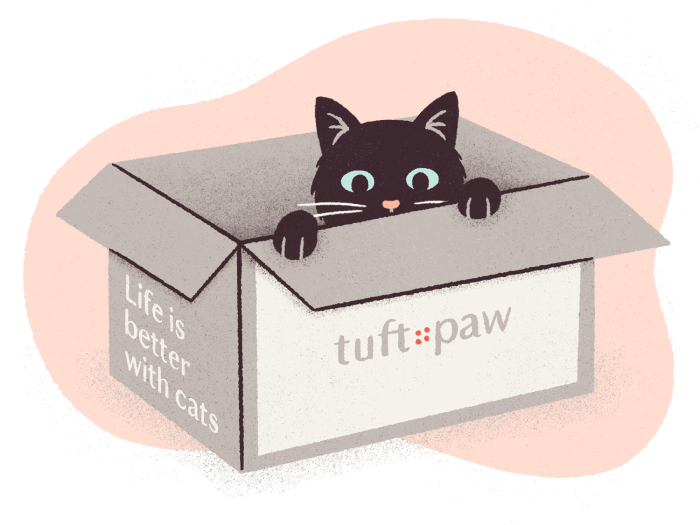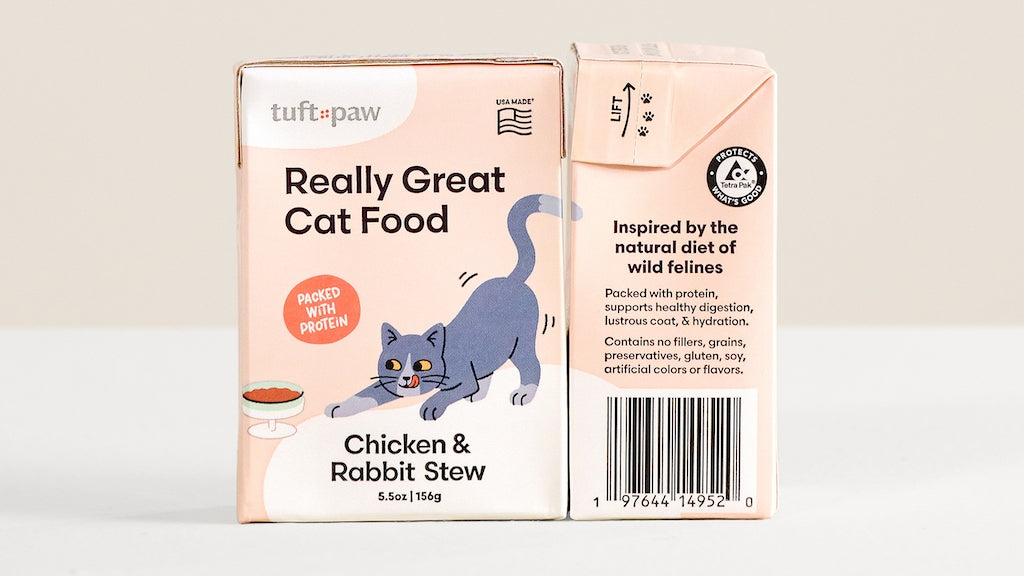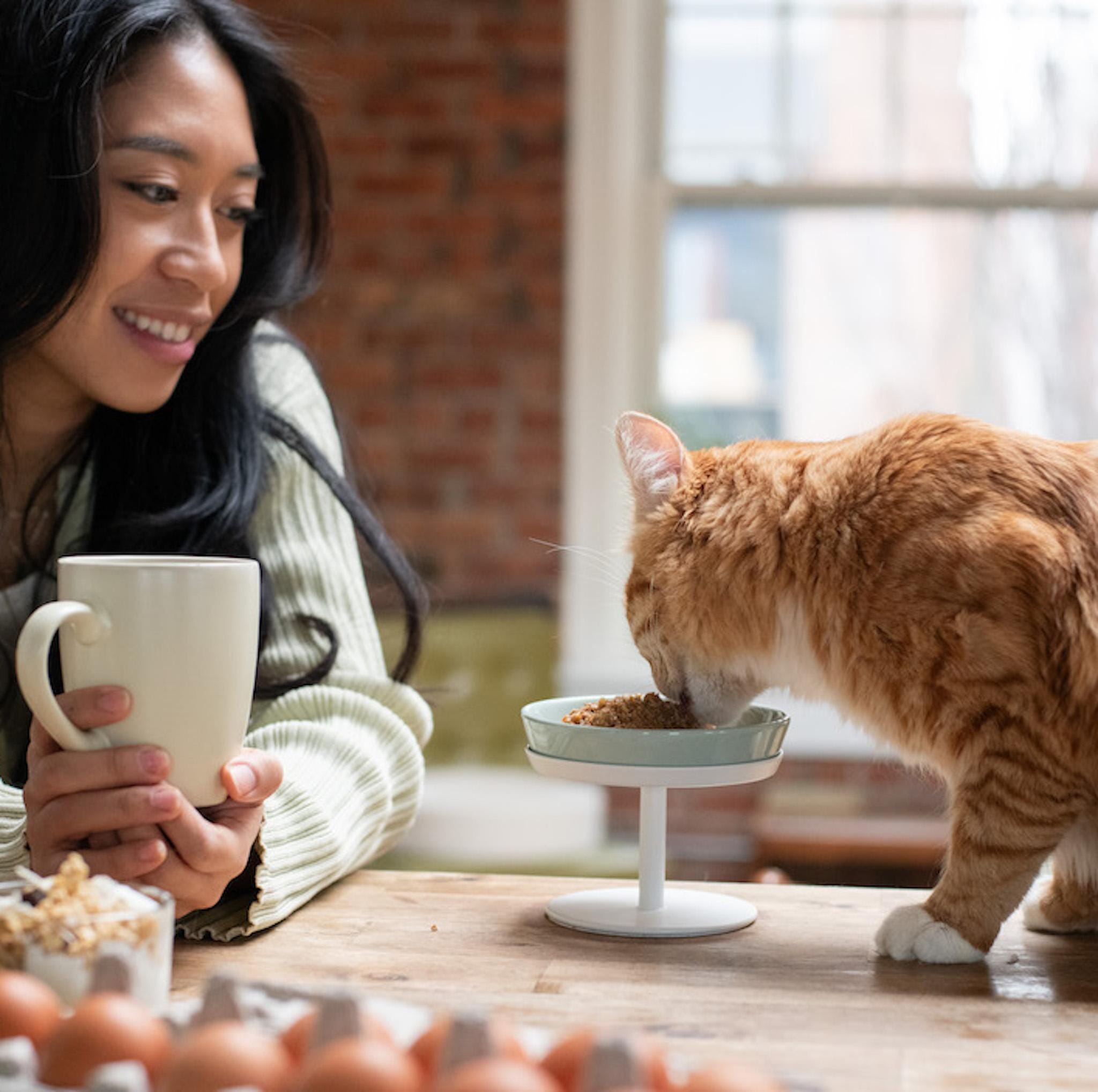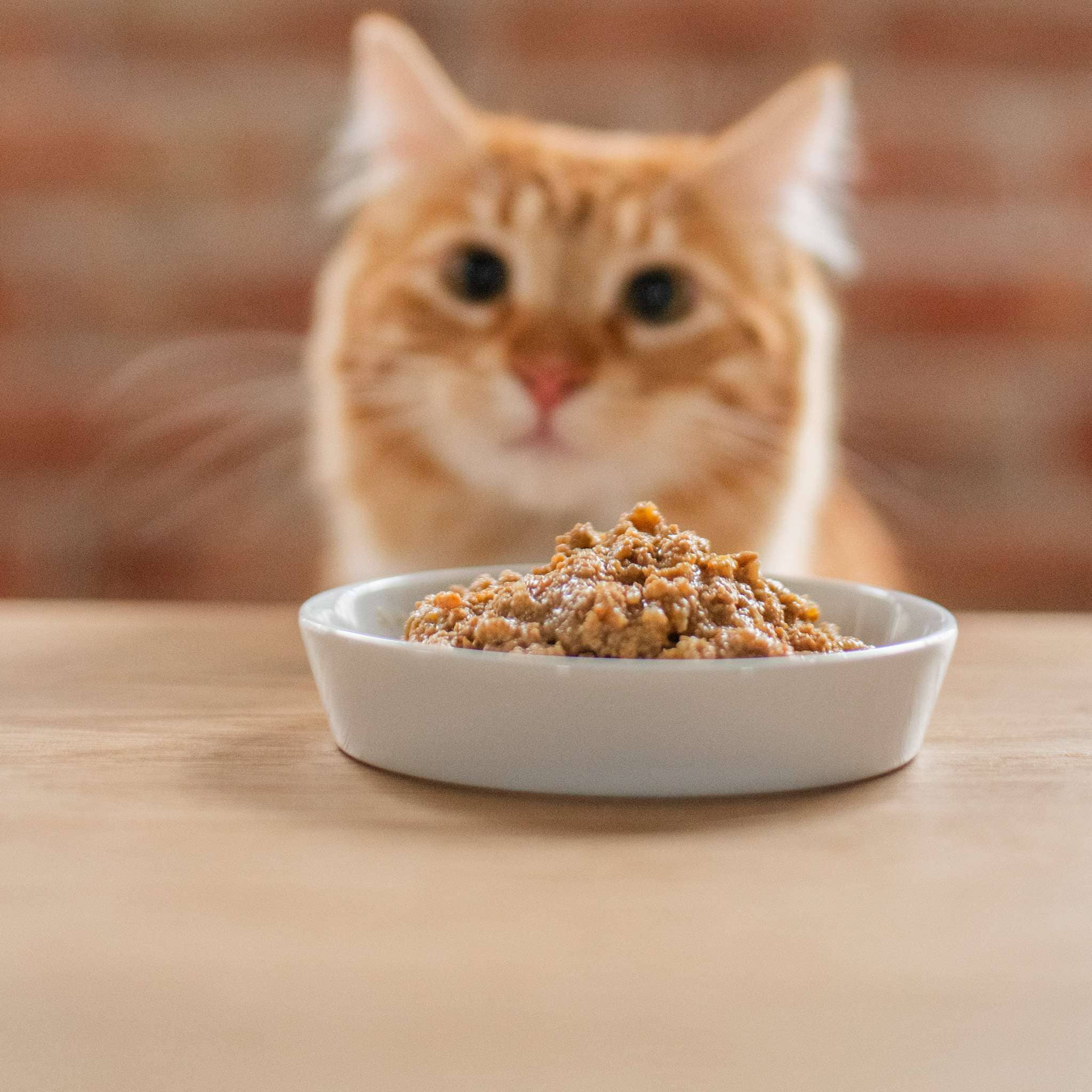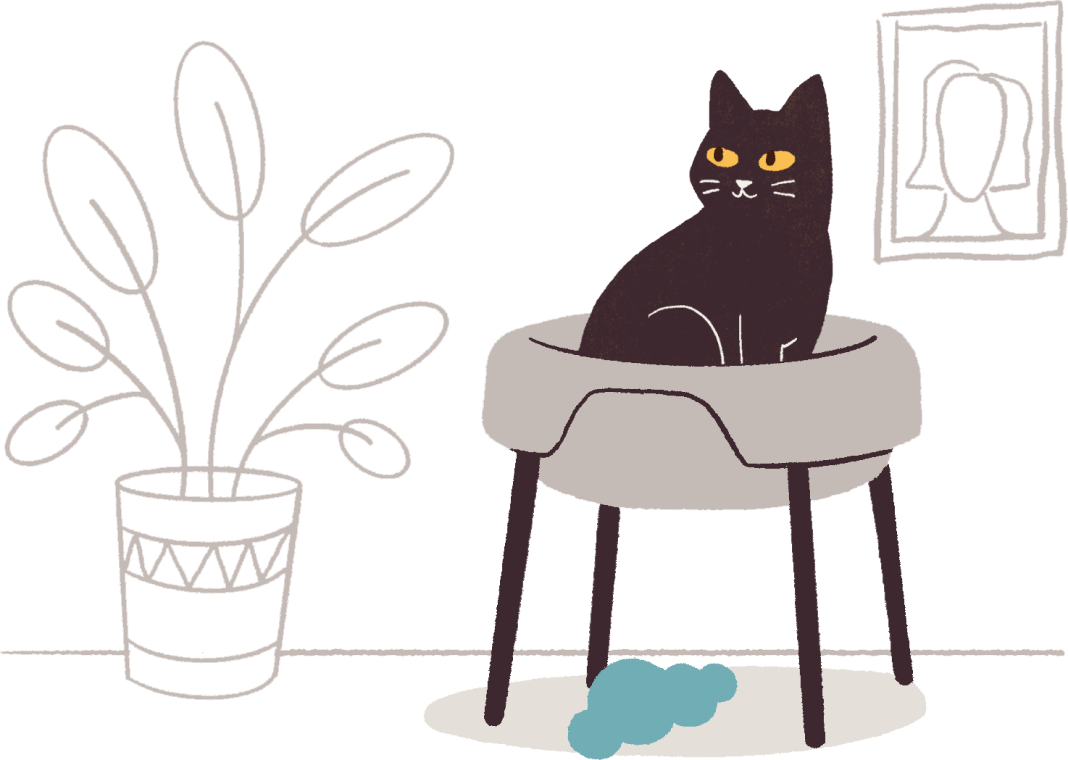When welcoming a new kitten into your home, one of the most important decisions is choosing the right kitten food. Providing the right nutrition is crucial for your kitten's growth and laying the foundation for a healthy and happy adult life. In this article, we'll go over what to look for in a good kitten food and give you our picks for the best kitten foods on the market today.
Here at tuft + paw, we are cat experts. We're intimately familiar with the cat food features that are most important to cats and cat parents alike. This list is based on consultation with a feline nutritionist, veterinarian, hundreds of online reviews, and our own experience as cat parents.
Tip: If your kitten lives indoors, check out our list of the best foods for indoor cats for when they transition to adult food.
Cheat Sheet: The Best Kitten Foods
1) Stella & Chewy’s Carnivore Cravings Purrfect Paté
| Pros | high quality animal protein, first 4 ingredients are animal based, affordably priced, salmon and tuna oil for omega-3s, high moisture content, soft texture for weaning off milk |
| Cons | contains sunflower oil and tapioca |
| Calories | 187 cal/5.2 oz can = 36 cal/oz |
| Price | $64.56 for 24 x 5.2 oz cans = $0.52/oz |
2) RAWZ 96% Turkey & Salmon Pate
| Pros | high quality animal protein, first 4 ingredients are animal-based, 96% turkey and salmon (exclusive of water), salmon for omega-3s, affordably priced, dandelion greens for dietary fiber, minimal carbs, good moisture content, soft texture for weaning off milk |
| Cons | not available at big retailers, slightly lower caloric density |
| Calories | 170 cal/5.5 oz can = 31 cal/oz |
| Price | $69.99 for 24 x 5.5 oz cans = $0.53/oz |
3) tuft + paw Really Great Cat Food
| Pros | high quality animal protein, first 2 ingredients are chicken-based, low carbohydrates, no fillers, dietary fiber to aid digestion, salmon oil for omega-3s, affordable price point, high moisture content, soft texture for weaning off milk |
| Cons | not available in pet stores, slightly lower caloric density |
| Calories | 138 cal/5.5 oz box = 25 cal/oz |
| Price | $69 for 24 x 5.5 oz box = $0.52/oz |
4) Tiki Cat Baby Mousse & Shreds Chicken & Salmon
| Pros | very high protein content, high quality animal protein, salmon and salmon oil for omega-3s, high moisture content, mixed soft textures for weaning off milk, available in small packs of 3 |
| Cons | expensive, contains sunflower seed oil and xanthan gum |
| Calories | 67 cal/1.9 oz can = 35 cal/oz |
| Price | $5.99 for 3 x 1.9 oz cans = $1.05 |
5) Wellness CORE Turkey & Chicken Liver Pate
| Pros | high quality animal protein, first 6 ingredients are animal based, fish oil for omega-3s, high moisture content, minimal carbohydrates, soft texture for weaning off milk |
| Cons | contains guar, cassia, xanthan gums |
| Calories | 199 cal/5.5 oz can = 36 cal/oz |
| Price | $83.76 for 24 x 5.5 oz cans = $0.63/oz |
6) Cat Person Chicken Shreds in Broth
| Pros | high quality animal protein, first 2 ingredients are chicken-based, very high moisture content, low carbs, fish oil for omega-3s, available as subscription |
| Cons | contains sunflower oil and tapioca, texture not ideal for weaning off milk |
| Calories | 99 cal/2.75 oz cup = 36 cal/oz |
| Price | $9.50 for 5 x 2.75 oz cups = $0.69/oz |
What is Kitten Food?
Kittens’ bodies are growing and developing rapidly for the first year of their lives, and their diet needs to fuel those processes. This means kittens can eat up to twice as many calories per day as adult cats (which begs the question: can kittens eat adult cat food?). They also have specific nutrient needs that differ from adult cats, such as a higher requirement for DHA: an omega-3 fatty acid need for brain and eye development. Along with their physical growth, a kitten’s food needs to provide enough calories to fuel their super active lifestyle of playing, climbing, and zooming around the house.
On any kitten food label, look for the AAFCO statement that says it meets the nutritional requirements for the “growth” life stage (kittens) or “all life stages” (kittens and adult cats). Follow the feeding instructions on the label and you’ll have most of your bases covered. See our guide on when to switch from kitten to cat food for more info.
 Really Great Cat Food & Dock Bowl and Stand by tuft + paw
Really Great Cat Food & Dock Bowl and Stand by tuft + paw
What to Look for In Kitten Food
Higher Caloric Density
Just like human babies, kittens are bundles of energy. They need a diet that packs a punch in terms of calories to fuel their playfulness and growth. Look for kitten foods with higher caloric density to ensure your little one is getting the energy they need.
Note: Growing kittens need fewer calories as they age. Cat parents should account for this when feeding a kitten to avoid overfeeding and obesity. The table below shows how to estimate your kitten's caloric needs based on their age and weight.
| Age | kcal/kg Body Weight | Example |
| 6-20 weeks | 250 | 1.4-kg kitten: 250 x 1.4 = 350 kcal/day |
| 4-6.5 months | 130 | 2.3-kg kitten: 130 x 2.3 = 299 kcal/day |
| 7-8.5 months | 100 | 2.7-kg kitten: 100 x 2.7 = 270 kcal/day |
| 9-11 months | 80 | 3.2-kg kitten: 80 x 3.2 = 256 kcal/day |
| 12 months | 60 | 3.4-kg cat: 60 x 3.4 = 204 kcal/day |
High-Quality Animal Protein
Cats are obligate carnivores, and kittens are no different. Protein is their main source of energy, and the AAFCO recommends that kittens get at least 30% of their calories from protein. Look for kitten food with a high-quality animal protein source as the primary ingredient (e.g. chicken, turkey liver, salmon). Also pay attention to protein digestibility; cats benefit most from easily digested animal proteins such as meat and organs. Avoid foods that rely on animal “byproducts” and “meal” for their protein content, as these can contain less digestible components like connective tissue and bones. Any high protein cat food should be as digestible as possible.
Low in Carbohydrates
All cat diets—regardless of age—should emphasize protein and healthy fats over carbohydrates. Cats in the wild consume relatively few carbs, and replicating this in their diet supports their nutritional needs. While kittens are capable of digesting carbohydrates, their digestive systems are far better adapted to digesting and absorbing nutrients from protein sources.
Tip: Check out our list of the best low carb cat foods and best grain-free cat foods (yes those are different things!)
 Really Great Cat Food & Dock Bowl and Stand by tuft + paw
Really Great Cat Food & Dock Bowl and Stand by tuft + paw
Sufficient Moisture Content
Proper hydration is vital for kittens, and the best way to ensure they get enough fluids is through their food. Wet kitten food with high moisture content not only helps in hydration but is also more palatable, making it ideal for picky eaters. Additionally, cat food for sensitive stomachs should have a high moisture content to make digestion as easy as possible.
Soft Texture
As kittens transition from milk to solid foods (~4 weeks old), their teeth are still in the early stages of development. A diet with a softer texture is not only easier on their gums but also encourages them to explore a variety of flavors without any chewing discomfort. Once they’re comfortable with patés, you can try introducing them to other textures like minces, meat shreds, and eventually kibble.
Supplementary Omega-3s
Kitten foods rich in omega-3 fatty acids (e.g. DHA) help with eye and brain development. Many kitten-specific foods will advertise a high DHA content, but it’s also worth checking the ingredients list for omega-3 sources like salmon, herring, or fish oil.
Meets AAFCO Nutritional Standards & Life Stage Requirements
When selecting kitten food, always check if it meets the nutritional standards set by the Association of American Feed Control Officials (AAFCO) for the “growth” life stage or “all life stages”. This ensures that the food is formulated to provide a complete and balanced diet for your kitten. AAFCO compliance is a crucial indicator of the food's quality and suitability for your kitten’s overall health.
Here is a detailed AAFCO document that covers cats nutritional needs in depth (starting on page 13).
Here are the key AAFCO terms you’ll see on a label:
- Complete and Balanced – “Complete” means the product contains all the nutrients required. “Balanced” means the nutrients are present in the correct ratios.
- “Growth” life stage – Early life stage when kittens have greater nutritional needs to fuel their growth and development.
- “Maintenance” life stage – Adult cats who are no longer growing only require nutrition for maintenance of a healthy body weight.
- “Gestation/lactation” life stage – Pregnant/mother cats who need to feed their kittens have greater nutritional needs than non-pregnant, non-lactating adult cats.
- All life stages – This means the food is appropriate for both kittens and adult cats, though feeding directions will vary depending on your cat’s life stage.
 Really Great Cat Food & Dock Bowl and Stand by tuft + paw
Really Great Cat Food & Dock Bowl and Stand by tuft + paw
Our Criteria for Choosing the Best Kitten Food
- Meets AAFCO Standards – All foods on this list are formulated to meet the AAFCO Cat Food Nutrient Profiles for either “growth” or “all life stages”.
- High quality animal protein – All foods on this list prioritize animal proteins as their first ingredients rather than animal byproducts.
- Healthy fats – Good kitten foods should have plenty of animal fats, as well as supplementary sources of omega-3 fatty acids.
- Calorie density – Kittens require more calories than adult cats to fuel their growth and energy levels.
- Moisture content – High moisture content in food helps kittens avoid the health problems associated with dehydration.
- Carbs & plant-based content – Kittens are obligate carnivores who should be eating primarily animal protein, so we prefer foods with low carbohydrate content and low plant material content.
- Price
Deep Dive: The Best Kitten Foods
1) Stella & Chewy’s Carnivore Cravings Purrfect Paté
 Credit: Stella & Chewy's
Credit: Stella & Chewy's
Price: $64.56 for 24 x 5.2 oz cans = $0.52/oz
Calories: 187 cal/5.2 oz can = 36 cal/oz
Life Stage: growth
Our pick for the best kitten food is Stella & Chewy’s Carnivore Cravings Purrfect Paté. This food offers plenty of easily digestible animal protein in the form of chicken, salmon, and dried egg. Salmon and tuna oil provide a boost of omega-3 fatty acids, which we love to see in kitten foods for their role in brain and eye development. If you happen to be the lucky caretaker of a kitten litter, the paté texture is soft enough for weaning kittens off of their mother’s milk. You also can’t argue with the price! At $0.52 per oz, this is an affordable food that still covers all your kitten’s nutritional bases.
The only real con is the inclusion of sunflower oil and tapioca. Both are plant-based ingredients that add calories and improve the texture of the food, but they are not nutritionally optimal for a kitten’s diet. However, these ingredients are hard to avoid in kitten food, so it’s not a deal breaker considering this formula’s other strengths.
|
Ingredients: Chicken, chicken broth, salmon, dried egg, sunflower oil, tapioca, tricalcium phosphate, salt, tuna oil, minerals (zinc oxide, reduced iron, sodium selenite, manganese sulfate, copper amino acid complex, potassium iodide), vitamins (vitamin E supplement, thiamine mononitrate, niacin supplement, vitamin A supplement, pyridoxine hydrochloride, D-calcium pantothenate, riboflavin supplement, folic acid, vitamin B12 supplement, vitamin D3 supplement, biotin), magnesium sulfate, potassium chloride, taurine, choline chloride, celery powder. |
|
Guaranteed Analysis
|
Dry Matter Analysis
|
| Pros | Cons |
|
|
2) RAWZ 96% Turkey and Salmon Pate Canned Food for Cats
 Credit: RAWZ
Credit: RAWZ
Price: $69.99 for 24 x 5.5 oz cans = $0.53/oz
Calories: 170 cal/5.5 oz can = 31 cal/oz
Life Stage: all life stages
RAWZ 96% Turkey and Salmon Paté is a high quality cat food that’s appropriate for all life stages—you’d just need to feed your kitten more than an adult cat. We love the high protein animal-based recipe, which is 96% turkey and salmon if you exclude the water content. On a dry matter basis, the brand reports that almost 56% of this food is protein. The salmon provides a rich source of omega-3 fatty acids for brain and eye development. This turkey and salmon paté is enticing for most cats, but RAWZ offers other formulas if your cat prefers different meats. Beyond meat and essential vitamins and minerals, the only other notable ingredients are fenugreek seeds and dandelion greens, which are suitable fiber sources to aid digestion. We also love the lack of gums and filler carbs and the reasonable price of $0.53/oz.
The only significant drawback to this food is that it’s not available at major online retailers and big box pet stores. This means it can be difficult to find if your local pet stores don’t stock it. It’s also not quite as calorie dense as some of the other foods on this list, but is still adequate.
|
Ingredients: Turkey, Salmon, Turkey Liver, Turkey Broth, Fenugreek Seeds, Dandelion Greens, Taurine, Natural Flavor, Potassium Chloride, Tricalcium Phosphate, Choline Chloride, Zinc Proteinate, Iron Proteinate, Niacin Supplement, Vitamin E Supplement, Copper Proteinate, Magnesium Proteinate, Sodium Selenite, Calcium Iodate, Thiamine Mononitrate, Manganese Proteinate, Vitamin A Supplement, Calcium Pantothenate, Riboflavin Supplement, Pyridoxine Hydrochloride, Salt, Biotin, Vitamin D3 Supplement, Vitamin B12 Supplement, Folic Acid. |
|
Guaranteed Analysis
|
Dry Matter Analysis
|
| Pros | Cons |
|
|
3) tuft + paw Really Great Cat Food
Price: $69 for 24 x 5.5 oz box = $0.52/oz
Calories: 138 cal/5.5 oz box = 25 cal/oz
Life Stage: all life stages
Disclaimer: Yes, we included our own cat food here. This is because we truly think it performs excellently compared to other cat foods on the market. We subjected it to the same scrutiny as every other food on this list and asked for honest opinions from experts and cat parents.
For older kittens, tuft + paw’s Really Great Cat Food is a high quality formula that checks all the boxes. The high protein formula prioritizes easily digestible meats from chicken and rabbit. These two meat sources provide essential amino acids and fatty acids, particularly taurine and arachidonic acid which are both especially vital to cats. There’s also the addition of salmon oil for omega-3s, which are crucial for brain and eye development in growing kittens. There are no filler carbs, and each plant-based ingredient is there to provide either specific vitamins, minerals, antioxidants, or dietary fiber. Given the quality of ingredients, it’s also quite affordable at $0.52/oz, and the stew texture is easy to chew for kittens and adult cats alike.
The only real weakness of Really Great Cat Food for kittens is its lower caloric density.This means young kittens who are growing super fast will need to eat more meals per day on this food compared to higher calorie formulas. Nonetheless, it has all the essential nutrients that kittens need to live a healthy, active life and would be perfectly suited to older kittens as they transition into adulthood.
|
Ingredients: chicken, chicken broth, pumpkin puree, rabbit, carrots, ground golden flaxseed, natural flavor, tricalcium phosphate, agar-agar, salmon oil, dandelion greens, potassium chloride, vitamins , magnesium amino acid chelate, choline chloride, taurine, minerals , sea salt. |
|
Guaranteed Analysis
|
Dry Matter Analysis
|
| Pros | Cons |
|
|
4) Tiki Cat Baby Mousse & Shreds Chicken & Salmon
 Credit: Chewy
Credit: Chewy
Price: $5.99 for 3 x 1.9 oz cans = $1.05
Calories: 67 cal/1.9 oz can = 35 cal/oz
Life Stage: all life stages
Tiki Cat’s Baby Mousse and Shreds is an excellent way to introduce new textures to your kitten while meeting all their nutritional needs. Each can has smooth pate and tiny shreds of meat so your kitten can acclimate to more solid food at their own pace. It comes in several different formulas, but we like this chicken and salmon recipe because it’s appealing to most cats and the salmon provides valuable omega-3s. The protein content is very high, with protein comprising 68% of dry matter. We also like the flexibility offered by the small packs of three cans, so you don’t have to commit to a large order right away.
Nutritionally this food is great for kittens, but the main drawback is the steep price. It comes out to $1.05 per ounce, which is significantly more expensive than any other food on this list. Considering how much kittens eat, this food could get expensive very quickly. Our only other gripe is with the inclusion of sunflower seed oil and xanthan gum, but as previously mentioned these ingredients are hard to avoid in kitten food. In our view, the benefits of this food’s very high protein content and convenient mix of textures outweigh this con.
|
Ingredients: Chicken, chicken broth, salmon, chicken liver, sunflower seed oil, dried egg, tricalcium phosphate, inulin, potassium chloride, xanthan gum, taurine, salmon oil, choline chloride, salt, magnesium sulfate, thiamine mononitrate (vitamin B1), vitamin E supplement, ferrous sulfate, niacin (vitamin B3), zinc oxide, vitamin A supplement, biotin, vitamin B12 supplement, sodium selenite, manganous oxide, calcium pantothenate, riboflavin supplement (vitamin B2), pyridoxine hydrochloride (vitamin B6), folic acid, potassium iodide, vitamin D3 supplement. |
|
Guaranteed Analysis
|
Dry Matter Analysis
|
| Pros | Cons |
|
|
5) Wellness CORE Turkey & Chicken Liver Pate Kitten Food
 Credit: Wellness Pet Food
Credit: Wellness Pet Food
Price: $83.76 for 24 x 5.5 oz cans = $0.63/oz
Calories: 199 cal/5.5 oz can = 36 cal/oz
Life Stage: all life stages
Wellness CORE offers a wide array of quality cat food recipes, but for kittens’ specific needs we like the Turkey & Chicken Liver Paté. The first six ingredients are all from animal sources, and the main proteins are easily digestible meats like turkey, chicken liver, and chicken. Herring and menhaden fish oil supply plenty of omega-3s to assist with cognitive development. The paté texture is soft and easy for kittens to eat when weaning off milk, and the inclusion of small amounts of plant fiber sources (e.g. flaxseed, chicory root extract) can help digestion.
The only thing we don’t really like about this formula is the inclusion of guar, cassia, and xanthan gums. These ingredients help thicken the paté texture, but they are not nutritionally necessary for cats. Price-wise, this food is $0.63 per ounce, which is middle of the pack.
|
Ingredients: Turkey, Chicken Liver, Turkey Broth, Chicken, Chicken Meal, Herring, Natural Flavor, Cranberries, Menhaden Fish Oil (preserved with Mixed Tocopherols), Guar Gum, Tricalcium Phosphate, Ground Flaxseed, Potassium Chloride, Choline Chloride, Taurine, Cassia Gum, Xanthan Gum, Dried Kelp, Chicory Root Extract, Yucca Schidigera Extract, Alfalfa Meal, Salt, Magnesium Sulfate, Iron Proteinate, Zinc Proteinate, Thiamine Mononitrate, Vitamin E Supplement, Copper Proteinate, Manganese Proteinate, Sodium Selenite, Niacin, d-Calcium Pantothenate, Pyridoxine Hydrochloride, Riboflavin Supplement, Vitamin A Supplement, Biotin, Potassium Iodide, Vitamin D3 Supplement, Vitamin B12 Supplement, Folic Acid, Rosemary Extract. |
|
Guaranteed Analysis
|
Dry Matter Analysis
|
| Pros | Cons |
|
|
6) Cat Person Chicken Shreds in Broth
 Credit: Cat Person
Credit: Cat Person
Price: $9.50 for 5 x 2.75 oz cups = $0.69/oz
Calories: 99 cal/2.75 oz cup = 36 cal/oz
Life Stage: all life stages
For older kittens that are ready to graduate from patés and eat solid meat, the Cat Person Chicken Shreds in Broth is a good option. As the name suggests, this food is predominantly shredded chicken in a savory chicken broth, which is appealing to most cats and offers a high protein content (59% of dry matter). We like the added fish oil for omega-3s and the very high moisture content, both of which will set your young feline up for a healthy future. Cat Person offers several other formulas if your cat doesn’t like chicken, and their subscription service is convenient and easy to navigate.
We wish this food didn’t rely on sunflower oil and tapioca for fat content and thickening, but as we’ve mentioned these are hard ingredients to avoid. The chicken shreds are also not easy to chew for very young kittens who are being introduced to solid food, which is why we recommend it for older kittens. It’s also somewhat on the pricier side at $0.69 per ounce.
|
Ingredients: Chicken, chicken broth, sunflower oil, tapioca, tricalcium phosphate, natural flavor (with added nutrients), fish oil, salt, potassium chloride, taurine, choline chloride, magnesium sulfate, vitamin e supplement, thiamine mononitrate, dried celery, zinc oxide, niacin supplement, reduced iron, Vitamin A supplement, sodium selenite, manganese sulfate, pyridoxine hydrochloride, copper amino acid complex, d-calcium pantothenate, riboflavin supplement, folic acid, Vitamin B12 supplement, Vitamin D3 supplement, biotin, potassium iodide. |
|
Guaranteed Analysis
|
Dry Matter Analysis
|
| Pros | Cons |
|
|
Kitten Food FAQs
Can kittens eat the same food as adult cats?
While kittens and adult cats share most dietary needs, kittens require different nutrient amounts for growth. It's important to either choose a kitten-specific formula that meets their higher energy and nutritional demands, or a food suitable for “all life stages” which they can eat in larger amounts.
What should I look for in kitten food?
Choosing kitten food with a higher caloric density, high-quality animal protein, low carbohydrates, sufficient moisture content, and meeting AAFCO nutritional standards is crucial for your kitten's healthy development. These elements support their energy needs, growth, and overall well-being.
How often should I feed my kitten?
Kittens have smaller stomachs and higher energy needs, requiring more frequent meals than adult cats. Generally, feeding them three to five times a day is recommended to support their growth and development.
Is wet or dry kitten food better?
Both wet and dry kitten foods have their advantages. Wet food provides higher moisture content while dry food may assist with dental health. A combination of both can offer a well-rounded diet. Keep in mind that young kittens should start weaning with soft wet food before trying dry food.
Can I make my kitten’s food at home?
Homemade diets can be challenging to balance correctly for a kitten's nutritional needs. It's generally advisable to choose commercial kitten food, specifically formulated to meet their requirements. If considering a homemade diet, consult with a veterinary nutritionist for guidance.
Conclusion
Providing the best food for your kitten requires careful consideration of their age-specific nutritional needs. The main things to look for are high quality animal protein and a higher caloric density than adult cat food, but you should also keep an eye out for ingredients rich in omega-3 fatty acids. Our favorite foods for kittens are Stella & Chewy’s Carnivore Cravings Purrfect Paté and RAWZ 96% Turkey and Salmon Paté because they cover all the bases at an affordable price. Tuft + paw’s Really Great Cat Food is a high quality option for older kittens as they transition to adulthood. On the other hand, Tiki Cat’s Baby Mousse & Shreds kitten food is pricey, but has very high protein content that will contribute to healthy growth. Other good options are Wellness CORE Turkey & Chicken Liver Paté for kittens that prefer soft textures and Cat Person Chicken Shreds in Broth for kittens that like meatier food. Try out a few different foods and see which one your kitten likes best. Good luck!
